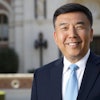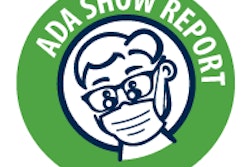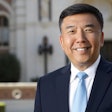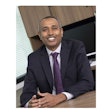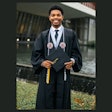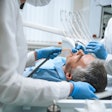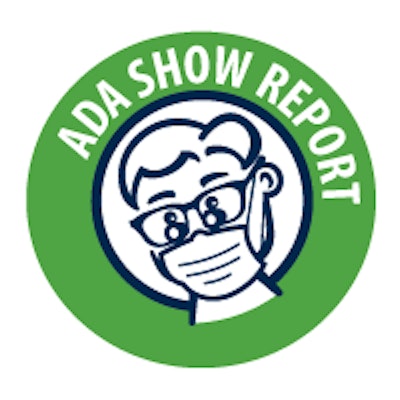
The setting couldn't have been more fitting for ADA 2013 -- Halloween in New Orleans. The home of voodoo and famous cemeteries -- and frequently cited as the Most Haunted City in America -- for four days hosted some 23,000 dental professionals dedicated to sweeping away fears of good oral health. Below are five top trends from this year's show.
1. The impact of changing economics on dentistry
The changing economic environment has become a frightening specter faced by many dentists, as a number of ADA presentations made clear. The looming arrival of the Patient Protection and Affordable Care Act (ACA), as well as the challenge of building a practice in the aftermath of the recession, the growth of corporate dental chains, and mushrooming dental school costs, are enough to scare the dickens out of any practicing dentist.
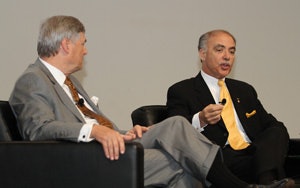 ADA president-elect Dr. Charles Norman III (left) and President Dr. Robert Faiella (right) during a town hall meeting at ADA 2013. Image courtesy of EZ Event Photography. © 2013 American Dental Association.
ADA president-elect Dr. Charles Norman III (left) and President Dr. Robert Faiella (right) during a town hall meeting at ADA 2013. Image courtesy of EZ Event Photography. © 2013 American Dental Association.
Fortunately, ADA 2013 talks offered some comfort. The ACA will bring millions of children into the dental care system since oral care is one of the law's essential health benefits. And millions of adults will qualify for Medicaid, but ADA President Robert Faiella, DMD, noted that many states have cut or reduced dental Medicaid coverage for adults.
Prepaid insurance benefits are declining, and the new law could also lead to direct reimbursement, he noted in an ADA town hall meeting. He also discussed the growth of corporate dental practices, and noted that many young dentists are choosing to work for dental service organizations. Many in the new generation of dentists don't want the responsibility of running a practice and want regular work hours to have more time for their families and personal interests, Faiella observed.
2. Former President Bill Clinton's address
The ADA scored quite a coup by securing former President Bill Clinton as the meeting's opening speaker on October 31. Once a bugbear to conservatives, attitudes toward Clinton appear to have softened since he left office, and he was well-received by the ADA audience.
Love him or hate him, everybody at the meeting who heard Clinton had an opinion about his address. The former president stressed the importance of overcoming partisan differences to solve the country's problems, recalling how he worked to overcome differences with Republicans to reach compromises on difficult issues.
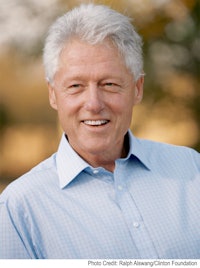 Former President Bill Clinton was the opening speaker at ADA 2013. Photo credit: Ralph Alswang/Clinton Foundation.
Former President Bill Clinton was the opening speaker at ADA 2013. Photo credit: Ralph Alswang/Clinton Foundation.
A retired dentist from Minnesota gave Clinton credit for urging politicians to stop fighting and instead focus on solving the country's problems. "He did a nice job and was very sincere," said Kim Harms, DDS, from Bloomington, MN. "I don't always agree with him politically, but he said how important it is to work together and stop being so divisive. It's a critical message for all of us: We have to learn to work together."
Dr. Harms now works with a nonprofit group on a project that has taken 80,000 dental books and 25 computers to Rwanda to train dental students. She noted that the Clinton Foundation is helping build a hospital in the country.
A Kansas dentist recounted how the former president, who enjoys playing the saxophone, described how he came to meet Al Hirt, the legendary trumpet player and New Orleans native son. Clinton was a 15-year-old boy visiting New Orleans with his mother when he tried to get into a club where Hirt was playing. After being turned away, the young Clinton then asked where he could find Hirt, and was told he was out back sitting in his car reading.
Determined to meet him, Clinton found Hirt's car and knocked on the window. After telling the trumpet player what a big fan he was, Hirt brought the young Clinton and his mom into the club to hear two sets. "The moral of the story is, if you do something kind for someone, you never know how that's going to end up," said Mark Hungerford, DDS, of Manhattan, KS.
For what it's worth, the ADA announced during the week that former President George W. Bush, who succeeded Clinton in office in 2001, has been scheduled to speak at ADA 2014 in San Antonio.
3. Social media is here to stay
Social media is another phenomenon that can be scary to many dentists, but a number of ADA speakers emphasized that there's nothing to be afraid of, with multiple sessions devoted to guiding clinicians and their staff on how to handle a business' social media presence.
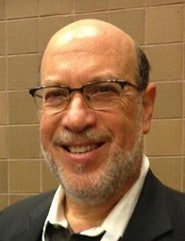 At the ADA Annual Session, Edward Zuckerberg, DDS, talked about how dentists can enhance their practice's profile with social media.
At the ADA Annual Session, Edward Zuckerberg, DDS, talked about how dentists can enhance their practice's profile with social media.
The potential benefits of a social media presence were made clear by one of the most recognizable surnames at the meeting, Edward Zuckerberg, DDS, father of Facebook founder Mark Zuckerberg. In his talk, he compared a positive review on a practice's page to digitized word of mouth.
But the process is not entirely intuitive. " 'If you build it, they will come' does not apply here," he explained.
So how does one generate interest for a dental practice that is competing for attention with rock bands and restaurants?
"You have to give some incentive to 'like' your page," Dr. Zuckerberg said. Promotions such as a whitening campaign resonate with users who are engaged to be married, he noted.
Other ADA talks focused on the rules of social media, such as how to respond to negative comments or what to do when a patient sends a friend request to a clinician's personal page. Any Facebook user can "like" a business, but access to a personal page requires acceptance of a friend request. The verdict is, unless you have a personal relationship with that patient outside of the doctor/patient dynamic, politely decline their request and suggest that they "like" your business' page.
"I get requests from patients who request to be friends," Dr. Zuckerberg said. "When we have no relationship other than as a patient, I politely request that they like my business page. But if we ARE friends -- fine."
4. Diversity gets its due
Diversity has become a major issue in dentistry, and this was nowhere more evident at ADA 2013, which highlighted a number of sessions dedicated to the topic.
"Sometimes patients look for those who reflect their own values," Linda Niessen, DMD, MPH, said during a supersession addressing issues impacting women in dentistry. "So diversity in an office is a strength -- it helps you deal with a range of patients. Recognize those strengths. They may not be gender-based."
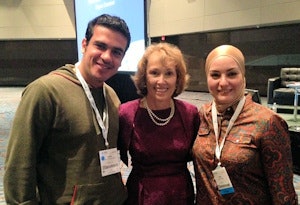 Haider Al Mohamadaway, DDS (left), and Arwa Alwehaib, DMD (right), were in attendance at the supersession hosted by Linda Niessen, DMD, MPH (center). Both are Iraqi expats who were practicing dentists in their home country. Both are residents who are studying to become licensed dentists in the U.S.
Haider Al Mohamadaway, DDS (left), and Arwa Alwehaib, DMD (right), were in attendance at the supersession hosted by Linda Niessen, DMD, MPH (center). Both are Iraqi expats who were practicing dentists in their home country. Both are residents who are studying to become licensed dentists in the U.S.
An array of sessions at the ADA meeting served to help clinicians meet the needs of a variety of patients. "Diversity topics are growing," said Dr. Niessen, a professor at the Nova Southeastern University College of Dental Medicine. "The ADA is paying attention, and I've seen that age and diversity topics have been incorporated into this year's meeting."
Several sessions focused on special issues in geriatrics, how to work with elder patients, and how to care for them. Another covered how to treat patients with disabilities. Others, such as the supersession, addressed the unique challenges -- and opportunities -- that women in dentistry face in a profession that is traditionally dominated by men.
"Previously, I worked in a pediatric office in a black neighborhood," said one clinician in attendance at the supersession. "The women there told me that in their community, children responded better [to women]. They were the authority in those households."
Different backgrounds can present interpersonal challenges in the work environment, and often the discussions on diversity turned to team-building concepts. Several clinicians shared stories about how their office exercises together. One practice closes early once a week to have a group yoga class or meditation.
5. Spooky New Orleans
 ADA attendees found New Orleans to be a haunting locale for the 2013 meeting.
ADA attendees found New Orleans to be a haunting locale for the 2013 meeting.
Finally, the ADA's opening day on Halloween gave the meeting a carnival feel, with many attendees and even some speakers dressing in costume. The exhibition hall also was lively, with a line band parading through the booths on Thursday and "go cups" appearing in the hands of attendees toward the end of the day as they chatted with vendors.
Still, the dark side of New Orleans was an undercurrent. A reporter who's attended several ADA meetings noted that the ID badges had warnings printed on the back, advising attendees to remove their badges when leaving the convention center so they looked less like tourists. "Stay alert and be aware of your surroundings as you enjoy New Orleans," the advisory read.
Some remarked that there seemed to be fewer attendees at this year's meeting, perhaps because dental professionals with children didn't want to miss Halloween. But the French Quarter was crowded with costumed revelers, and the music and food were as good as ever.

